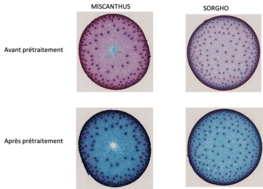Alkaline Pretreatments for Sorghum and Miscanthus Anaerobic Digestion: Impacts at Cell Wall and Tissue Scales
Observation à l’échelle cellulaire et tissulaire de l’impact des prétraitements alcalins sur le comportement de la biomasse lignocellulosique de Sorgho et de Miscanthus au cours de la méthanisation
Hélène Laurence Thomas, Helga Felix P. Nolasco, Hélène Carrère, Marc Lartaud, Tuong-Vi Cao, et al.. Alkaline Pretreatments for Sorghum and Miscanthus Anaerobic Digestion: Impacts at Cell Wall and Tissue Scales. BioEnergy Research, Springer, In press, ⟨10.1007/s12155-021-10342-9⟩. ⟨hal-03539190⟩https://hal.inrae.fr/hal-03539190
Abstract
Lignocellulosic biomass is hardly degraded during anaerobic digestion. Among a large panel of pretreatments used to improve the biodegradability of this substrate, alkaline pretreatments are recognized as the most efficient to remove lignin and therefore improve the methane production of these substrates. This article uses different histological stains (FASGA, phloroglucinol, Maule reagent, Congo red), immunolocalization, and histological quantification on pretreated internode stem tissue section in order to decipher the mechanism of alkaline pretreatment action (CaO and NaOH) in the anatomical and lignocellulosic matrix scale of Sorghum Biomass 140 hybrid and of Miscanthus x giganteus Floridulus. A significant delignification of all tissues was observed (sclerenchyma, parenchyma, and xylem) except in the epidermis and in the internal part of the perivascular sclerenchyma. The degradation of lignin under the effect of alkaline pretreatment is accompanied by a massive unmasking of cellulose and a reduction of crystalline cellulose. This induced an increase of anaerobic digestion kinetics for both biomass and of methane yield for miscanthus. Miscanthus is rich in G-type lignins located mainly at the level of the perivascular sclerenchyma of the external internode zone which was more degraded by alkalies than the S-type lignin; this may explain the improvement of miscanthus methane potential.
Publiée : 02/02/2022

